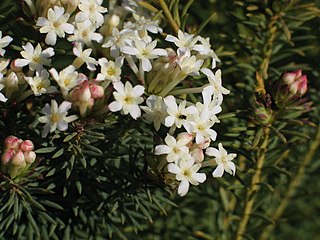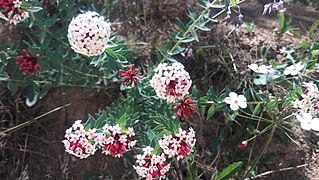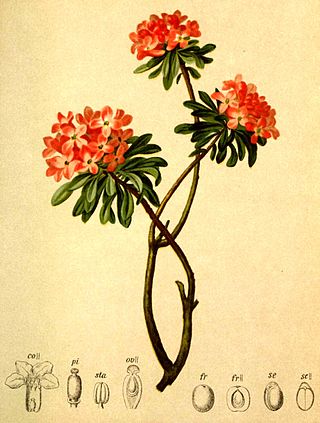
The Scrophulariaceae are a family of flowering plants, commonly known as the figwort family. The plants are annual and perennial herbs, as well as shrubs. Flowers have bilateral (zygomorphic) or rarely radial (actinomorphic) symmetry. The Scrophulariaceae have a cosmopolitan distribution, with the majority found in temperate areas, including tropical mountains. The family name is based on the name of the included genus Scrophularia L.

Daphne is a genus of between 70 and 95 species of deciduous and evergreen shrubs in the family Thymelaeaceae, native to Asia, Europe and north Africa. They are noted for their scented flowers and often brightly coloured berries. Two species are used to make paper. Many species are grown in gardens as ornamental plants; the smaller species are often used in rock gardens. All parts of daphnes are poisonous, especially the berries.
Gonystylus is a southeast Asian genus of about 30 species of hardwood trees also known as ramin, melawis (Malay) and ramin telur (Sarawak).

Rhodiola is a genus of perennial plants in the family Crassulaceae that resemble Sedum and other members of the family. Like sedums, Rhodiola species are often called stonecrops. Some authors merge Rhodiola into Sedum.

Gnidia is a genus of flowering plants in the family Thymelaeaceae. It is distributed in Africa, Madagascar, Arabia, India, and Sri Lanka; more than half of all the species are endemic to South Africa. Gnidia was named for Knidos, an Ancient Greek city located in modern-day Turkey.
Solmsia is a genus containing one or two species of flowering plants belonging to the family Thymelaeaceae. It is endemic to New Caledonia. The genus was named to honor Hermann zu Solms-Laubach by Henri Ernest Baillon. It is related to Arnhemia, Deltaria, Gonystylus and Lethedon.

Phaleria is flowering plant genus of about 20–25 species in the family Thymelaeaceae.

Malveae is a tribe of flowering plants in the mallow family Malvaceae, subfamily Malvoideae. The tribe circumscribes approximately 70 genera and 1040 species and has the greatest species diversity out the three tribes that make up Malvoideae. The flowers of Malveae are five-merous with a characteristic staminal column, a trait found throughout Malvoideae. Although there are not many economically important species within Malveae, the tribe includes Althaea officinalis, otherwise known as the marsh-mallow.

Edgeworthia is a genus of plants in the family Thymelaeaceae. When the genus was first described, it was published twice in the same year (1841), in two separate publications: Plantarum vascularium genera: secundum ordines naturales digesta eorumque differentiae et affinitates tabulis diagnostacis expositae; and Denkschriften der Regensburgischen Botanischen Gesellschaft. The genus was named in honour of Michael Pakenham Edgeworth, an Irish-born botanist and official in the Bengal Civil Service, then stationed in India, and for his half-sister, writer Maria Edgeworth.

Amaryllidoideae is a subfamily of monocot flowering plants in the family Amaryllidaceae, order Asparagales. The most recent APG classification, APG III, takes a broad view of the Amaryllidaceae, which then has three subfamilies, one of which is Amaryllidoideae, and the others are Allioideae and Agapanthoideae. The subfamily consists of about seventy genera, with over eight hundred species, and a worldwide distribution.
Wikstroemia johnplewsii, common name Hiva Oa ohelo, is a plant species endemic to the island of Hiva Oa in the Marquesas Islands, French Polynesia. It is found at relatively high altitudes in the mountains, at elevations over 600 m. The only other member of the genus reported from the Marquesas is W. coriacea. Wikstroemia coriacea has narrower leaves and smaller inflorescences than. W. johnplewsii.
Durioneae is a tribe within the subfamily Helicteroideae of the plant family Malvaceae s.l. The tribe contains at least five genera, including Durio, the genus of tree species that produce Durian fruits.

Clinantheae is a tribe, where it forms part of the Andean clade, one of two American clades. The tribe was described in 2000 by Alan Meerow et al. as a result of a molecular phylogenetic study of the American Amaryllidoideae. This demonstrated that the tribe Stenomesseae, including the type genus Stenomesson was polyphyletic. Part of the tribe segregated with the Eucharideae and were submerged into it, while the other part formed a unique subclade. Since the type species of Stenomesson was not part of the second subclade, it was necessary to form a new name for the remaining species together with the other genera that remained. This was Clinanthus, the oldest name for these species, and consequently the tribe Clinantheae.
Deltaria brachyblastophora is a species of shrubs in the Thymelaeaceae family. It is endemic to New Caledonia and the only species of the genus Deltaria. It is related to Arnhemia, Gonystylus, Lethedon and Solmsia.
Lethedon is a genus of shrubs in the Thymelaeaceae family from Australia and New Caledonia. It is related to Arnhemia, Deltaria, Gonystylus and Solmsia.

Stellera is a genus of flowering plant in the family Thymelaeaceae, with a single species Stellera chamaejasme found in mountainous regions of Central Asia, China, Siberia and South Asia. S. chamaejasme is a herbaceous perennial plant with heads of white, pink or yellow flowers, grown as an ornamental plant in rock gardens and alpine houses, but considered a weed playing a rôle in the desertification of grasslands in parts of its native range. Like many others of its family, it is a poisonous plant with medicinal and other useful properties.

Diarthron is a genus of flowering plant in the family Thymelaeaceae. The precise limits of the genus are uncertain. When broadly circumscribed to include Dendrostellera and Stelleropsis, it consists of annual and perennial herbaceous plants and small shrubs, with reddish, white or green flowers lacking petals, and is found in central and south-west Asia and south-east Europe.

Octolepidoideae is a subfamily and one of the earliest branches of the Thymelaeaceae family. This species inherited multiple morphological character states from its ancestor, Thymelaeaceae. The calyx of a typical octolepidoideae is 5-merous. Researchers have found the species to contain 4-merous and 6-merous calyces, albeit they remain rarer.

Thymelaeoideae is a subfamily of the Thymelaeaceae family.

Dais is a genus of flowering plants in the family Thymelaeaceae. It is also part of the Gnidia subfamily, along with Gnidia, Drapetes, Kelleria, Pimelea, Struthiola, Lachnaea and Passerina, other genera of species). It is distributed between Tanzania to S. Africa, Madagascar. It is native to the countries of Eswatini, Lesotho, Madagascar, Malawi, Tanzania, Zimbabwe and it is also found within several Provinces of South Africa, such as Cape Provinces, Free State, KwaZulu-Natal and Northern Provinces.



































